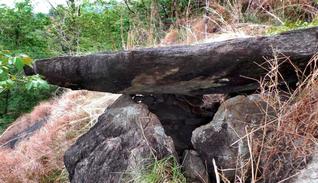
.jpg)

.jpg)
A team of archaeologists has discovered a prehistoric rock shelter near the Nedumala caves at the Piralimattom hills in Majalloor grama panchayat of Ernakulam district, bordering Idukki.
The study, led by P.Rajendran, Kerala University research scientist and archaeologist, was a follow-up of research at three prehistoric caves and nearby archaeological cites.
Rock shelters are the remains of living spaces of prehistoric period and need further research, Dr. Rajendran said. Unlike menheirs, rocks shelters had rarely been discovered. The caves at Piralimattom had elaborate petroglyphs in cupules and shallow grinding surface forms, mainly on vertical walls and a few on the ceiling.
These types of petroglyphs were first discovered in Kerala at Mattidampara at Kadakkal in Kollam recently. This was the second such discovery in the State, Dr. Rajendran said, emphasising the need for further research at the sites.
The team identified several cupules and grinding surfaces connected to the prehistoric period and paleoart inside the caves.
Dr. Rajendran said such petroglyphs were found in prehistoric cultural stages beginning from early Palaeolithic of the Pleistocene period to the late Holocene cultures.
He said the shallow grinding surfaces within the caves pointed towards its chronology to the Neolithic period of around 4000 BC. He said excavations could also unravel early Stone Age evidences from the thick deposit of earth within the caves.
Dr. Rajendran said though the oldest cupules had been reported from Olduvai Gorge in Tanzania in Africa, Bhimbetka in Madhya Pradesh too had archaeological findings not much later than that period. He said the site needed to be protected for its archaeological importance.
Source: The Hindu, 17 March 2014